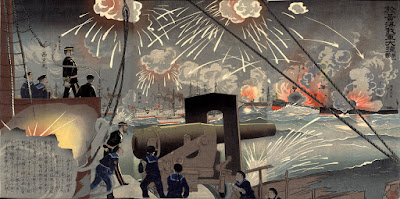 |
A Western newspaper's depiction of Japanese soldiers
mutilating bodies.
|
On November 21st, 1894, the Japanese city of Lüshunkou (better known in the West as Port Arthur) was taken. The Japanese army raped women and then massacred all the inhabitants in such a brutal event that goes by the name of "The Slaughter of Port Arthur."
 |
First Sino-Japanese War, major battles and troop movements.
|
The war was fought between Chinese Qing Dynasty and Japanese Meiji over the control of the Korean peninsula.
 |
Satirical drawing in the magazine Punch (29 September 1894), showing the
victory of "small" Japan over "large" China.
|
The war seems to have been a clear indication of the failure of the Chinese Qing Dynasty to modernize its military forces.
 |
Itō Sukeyuki was the Commander-in-Chief of the Japanese combined
fleet.
|
The defeat to Chinese and Japanese expansionism over Korea and Manchuria in northern China, showed that a confrontation with Russia was only a matter of time.
 |
The Battle of the Yalu River.
|
The success of the so-called Meiji Restoration was found with the first Japanese domination over East Asia. That defeat led to a series of revolutions and political changes in China, led by doctor Sun Yat-Sen and Kang-Youwei, which lead to the 1911 Revolution.
 |
An illustration of Japanese soldiers beheading 38
Chinese soldiers as a warning to others by Utagawa Kokunimasa.
|
No hay comentarios:
Publicar un comentario